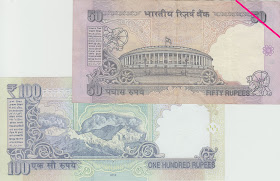As soon as they come into circulation, sides (corners in particular) get damaged.
For the face value of a banknote, this doesn't matter much.
As long as the banknote is complete and all printing is legible, there won't be much discussion about it's value.
For collectors, who are of course much more demanding, the items we collect should be perfect or at least as good as we can get, until a better item replaces our collectible.
(Or is it because our collection becomes more valuable according the catalogues we use ?)
A second reason to collect UNC notes (uncirculated), is of course the fact that UNC notes are less common then used notes. As soon as they come into circulation, they are no longer UNcirculated.
I'm blessed to have friends ... who can provide me UNC notes from all over the world.
One of the largest countries in the world (with over 1.2 billion people) is India.
No wonder millions and millions of banknotes are in circulation.
As the design of Indian rupee notes has changed recently, introducing the new currency sign 
 |
| regular rupee symbol |
 |
| fancy itallic rupee symbol |
The design
resembles both the Devanagari letter "र" (ra) and the Latin capital letter "R",
with a double horizontal line at the top.
(Double) strokes in a currency symbol refer to the 'stability' of a currency.
They can be found in £ (british pound); € (euro); $ (us dollar); ¥ (japanese yen)....
for more information : see the pages on wikipedia below :
( ₳ ฿ ₵ ¢ ₡ ₢ ₠ $ ₫ ৳ ₯ € ƒ ₣ ₲ ₴ ₭ ℳ ₥ ₦ ₧ ₱ ₰ £ ₹ ₨ ₪ ₸ ₮ ₩ ¥ ៛ )
( ₳ ฿ ₵ ¢ ₡ ₢ ₠ $ ₫ ৳ ₯ € ƒ ₣ ₲ ₴ ₭ ℳ ₥ ₦ ₧ ₱ ₰ £ ₹ ₨ ₪ ₸ ₮ ₩ ¥ ៛ )
The notes of  5 ;
5 ;  50 and
50 and  500 don't have the symbol yet.
500 don't have the symbol yet.
 |
 |
The higher denominations bare some security features, but I'm planning a set of articles on those features, so they will be subject to later posts.
 |
 |
to be continued ...
No comments:
Post a Comment